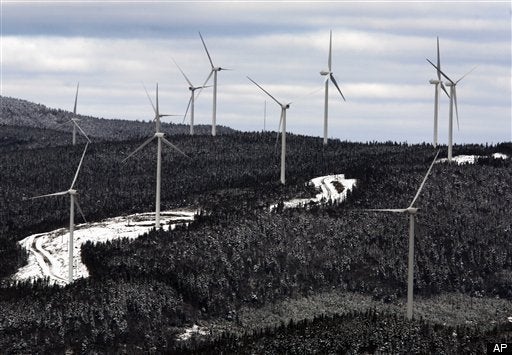
(This is Idea No. 5 in Huffington Post's ongoing America Needs Jobs series; see the introduction.)
Could one major crisis be solved.... by solving another?
If we're talking about the nation's desperately poor job market on the one hand, and the dire threat of climate change on the other, then the answer is: Quite possibly, yes.
The solution to both would be an enormous investment in green technology and green jobs -- creating a robust "clean energy economy" while reducing carbon emissions; putting millions of Americans back to work while increasing our energy independence; rebuilding our manufacturing base while saving consumers money on their energy bills; and saving the planet.
It certainly sounds a heck of a lot cheerier than the alternative.
And it makes sense that to genuinely restart the American jobs engine, you're going to need something really big.
Here's University of Texas economist James Galbraith putting today's need in historical perspective:
The illusion of stimulus was that the economy would "return to normal" with a little "fiscal boost." The reality is that having exhausted (however imperfectly) the 1940s agenda of middle-class housing, the 1950s highways agenda, the 1960s health-care agenda and the 1990s information-technology bubble, the economy needs a new strategic direction. The clear and pressing priorities are energy and climate change. To address these challenges is a grand task, requiring decades of research, careful planning and many investments, if we are to pass on a livable planet and a decent living standard. Institutionally it will require new lending agencies to assure that the funds needed are available over the long term. And the work can provide jobs for millions, for many years.
In a major report issued last year, John Podesta and colleagues at the Center for American Progress described the characteristics of a clean energy economy. Among its attractive qualities, it promises to revive the American middle class:
Solving global warming means investment. Retooling the energy systems that fuel our economy will involve rebuilding our nation's infrastructure. We will create millions of middle-class jobs along the way, revitalize our manufacturing sector, increase American competitiveness, reduce our dependence on oil, and boost technological innovation. These investments in the foundation of our economy can also provide an opportunity for more broadly shared prosperity through better training, stronger local economies, and new career ladders into the middle class. Reducing greenhouse gas pollution is critical to solving global warming, but it is only one part of the work ahead. Building a robust economy that grows more vibrant as we move beyond the Carbon Age is the greater and more inspiring challenge.
Famed venture capitalist John Doerr is an evangelist for clean energy and one of seven business leaders (also including Bill Gates and Jeff Immelt) who make up the American Energy Innovation Council (AEIC). That group is calling for "both robust, public investments in innovative energy technologies as well as policy reforms to deploy these technologies on a large scale."
Here's how Doerr explains the group's thinking:
Well, today, we are in a worldwide race for the next great global industry. And I believe, and my partners believe, the president and members of Congress believe that is the new clean-energy technologies....
[I]f you look at the top 30 companies around the world in new clean energy -- that's the top 10 in wind, the top 10 in solar, and the top 10 in advanced batteries, the sort that would power our electric vehicles -- only four of those 30 are American companies.
If I compare that to the Internet, it's -- it's as if, gosh, Microsoft and Apple and Google and Intel and Yahoo! were all companies headquartered in Europe or Asia, and only Amazon was a company here in the United States.
So, we have got to make choices, make decisions now about whether we want to be making our own energy future with American jobs, or if we want to be buying that future from China and other countries around the world.
There are many different paths to a green jobs future. The AEIC's plan, for instance, calls for $16 billion in annual federal government investment in clean energy innovation. Senate Energy and Natural Resources Committee Chairman Jeff Bingaman (D-N.M.) is still pushing for a "Green Bank," at a cost of $10 billion a year, that would facilitate "significant and sustained investment" in new clean-energy technologies.
(Bingaman, however, will be lucky if he can win passage of his bipartisan Renewable Energy Standard bill, written with Republican Senator Sam Brownback of Kansas, which would require utilities to get 15 percent of their power from renewable energy sources like wind and solar by 2021.)
So what may be the last, best hope for major federal clean-energy investment is a retooled green bank proposal that former FCC chairman Reed Hundt is pushing.
Bowing to the political realities -- that, as he puts it, "Congress won't appropriate any money now for any cause, no matter how worthy" and that unemployment is a more urgent priority than clean energy -- Hundt is advocating a nonprofit Energy Independence Trust (EIT) that he bills as a massive jobs generator, and that he says would not require appropriations because it would just be borrowing money from the Treasury.
At the core of the proposal is Hundt's embrace of one of the many facts that deficit hawks try to ignore: that despite concerns that high deficits will force the U.S. to increase interest rates, the Treasury is currently able to borrow money -- i.e. sell Treasury bills -- at stunningly low rates.
"You want to take the astoundingly low interest rates that the government has to pay to borrow money, and you want to transfer that to the degree possible to productive, revenue-producing businesses," Hundt told HuffPost. "There's a huge unmet need for productive new investment, but the only way to really prime the pump is to put in really cheap capital."
The investments Hundt is talking about, however, need to generate returns. "You want to build toll roads, not roads; dams that produce electricity, where you get paid back after a long period of time; electric transmission lines, where the revenue comes in from carrying the electricity; wind farms, where the revenue comes in from selling the electricity."
The Treasury would sell securities at very low interest, lend the money at cost to the EIT, and the EIT would then turn around and lend it to private investors. Hundt calls this "really, really, low, wonderfully low, cheap capital for investors who will build these clean energy systems."
And everyone would eventually get paid back.
"It's really pretty simple. In fact, it's what China does," Hundt said. "And in fact China has used low-cost lending to stimulate about twice as much clean energy investing as we have in the United States."
But how many jobs would this create?
"Roughly speaking, $1 billion in capital is 10,000 direct jobs and about 50,000 indirect jobs," Hundt said. "So one way to do it is say: How many jobs to you want?
"So if you tell me you want a million jobs, then I need $100 billion of investment, which means that I need probably about $30 billion of cheap capital, because the rest would come from other forms of capital."
Meanwhile, that $100 billlion would buy an awful lot of clean power. "Everyone knows that we need to build a clean energy system to replace a dirty energy system," Hundt said.
The plan also allows for private industry and the states to be the decisionmakers. "I don't believe that we need some kind of federal, national comprehensive, Washington-dictated solution. Electricity is a very local business," Hundt said.
"But I do believe if we said to all the states and all the businesses: Here's a once-in-a-lifetime opportunity for very cheap capital... then we would be opening the door to a variety of technological solutions that would be selected on the local level....
"If you want to rebuild the country, this is a golden opportunity."
*************************
NEXT IN THE AMERICA NEEDS JOBS SERIES: A Shorter Work Week
(Want to learn more about the series? Read the overview. Got an idea you think we may have overlooked? Email froomkin@huffingtonpost.com.)
*************************
Dan Froomkin is senior Washington correspondent for the Huffington Post. You can send him an e-mail, bookmark his page; subscribe to RSS feed, follow him on Twitter, friend him on Facebook, and/or become a fan and get e-mail alerts when he writes.
